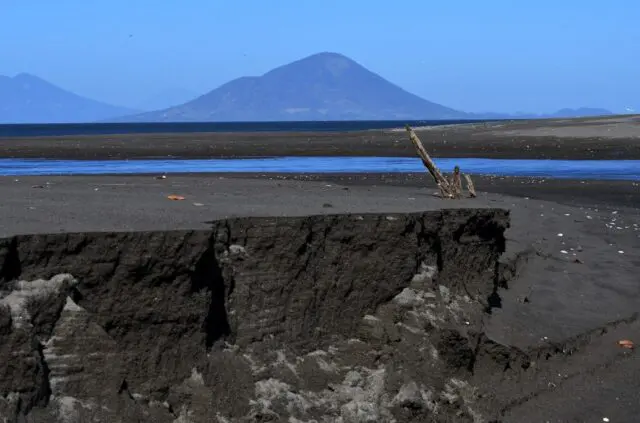Sea waves, just like a slow tsunami, are washing away mainland property in Cedeño and half a dozen fishing villages in the Gulf of Fonseca, some 100 km south of Tegucigalpa and which Honduras shares with El Salvador and Nicaragua. “The sea has been advancing”, laments Telma Yadira Flores, a 40-year-old housewife who lost her concrete home last year and now lives in a dilapidated clapboard house whose kitchen has beach sand as a floor.
Faced with the growing danger of her, Telma, who lives with her son and her daughter-in-law, she fears that the situation will repeat itself. “If the sea gets in again we have to evacuate and see where we are going.” With some 7,000 inhabitants, “Cedeño could completely disappear in 100 years”, warns a report by the non-governmental Committee for the Defense and Development of the Flora and Fauna of the Gulf of Fonseca (Coddeffagolf).
Environmentalists consider the Gulf, a paradise of splendid sunsets, as the “zero ground” or the greatest impact of climate change in Honduras. UN Secretary General Antonio Guterres recently warned of the risk of an exodus “of biblical proportions” due to rising sea levels caused by global warming and that “entire countries could disappear forever”.
The sea is “eating” dry land
The strong swells have knocked down part of the natural coconut barrier, destroying walls, houses, a marine laboratory, mansions of the rich and famous, and businesses of small entrepreneurs. In Cedeño, the environment of desolation is visible: the Michel Hasbún school, attended by some 400 children, was abandoned, as was the police headquarters and the community’s central park.
The sea has been “advancing” to flood 105 meters in 17 years, Jorge Reyes, head of Coddeffagolf Projects, told AFP based on the report. The report establishes what Cedeño was like in 2004 and then in 2021. “The sea has eaten 6 blocks (600 meters). There was even a soccer field; that field was lost”, says Sergio Espinal, a 75-year-old fisherman. “There were good restaurants and good hotels”, he said many years ago.

Endangered species
Inhabitants of Cedeño are witnesses of the disappearance of species of crustaceans and mollusks, whose habitat is in the roots of the mangrove forests. The transformation is such that Cedeño beach is now an extensive sandy mantle like a desert, although when the tide rises at certain times of the day it is covered by water. Sea birds, such as pelicans, earwigs and seagulls, fly over trying to survive, in the midst of the scarcity of fish.
“Before there were herds of dolphins, there were sharks, swordfish were caught (…) and now everything has been lost”, laments boatman Luis Fernando Ortiz, 39, as he navigates the turquoise blue waters. “That was Elvin Santos’ house”, he says, alluding to the former vice president (2006-2008), while he points to a destroyed mansion. The cause of the environmental deterioration is due to “the melting of the glaciers, which is increasing the flow of the sea”, explains Reyes.
The most sensitive signs for the coastal population are the destruction and depletion of the species that forces artisanal fishermen to “travel long distances to be able to fish”, he says. To mitigate “we are betting (…) on the restoration, both of ecosystems and the submersion of domes to rebuild artificial reefs” and on mangrove reforestation, she explains. At the global level, he believes that countries must commit to doing what is “humanly possible” to improve the management of solid waste and plastic that is affecting the ocean.
According to a report by the United Nations Environment Program (UNEP), 11 million metric tons of plastic enter the sea each year. This figure may triple in the next 20 years.
Saving the ocean
On March 2nd and 3rd, leaders from governments, the private sector, civil society and academics discussed how to save marine resources at the annual Our Ocean 2023 conference. “The ocean is one of humanity’s most valuable resources: it is home to 80% of all life on Earth, it provides food for more than 3 billion people”, the organizers state. However, they warn that “this vital asset is endangered by global warming” and “it is time for nations to work together to prevent” its further destruction.


The Pacific Ocean has long been a vital source of life and livelihood for coastal communities across the world, and new research highlights the devastating impact of climate change on this body of water. The study, conducted in Honduras, shows the stark effects of global warming on marine ecosystems, from bleached corals to dwindling fish populations. These “footprints” of climate change are clear and urgent, driving home the need for swift action to mitigate the worst impacts of our changing climate.
Thank you for your insight